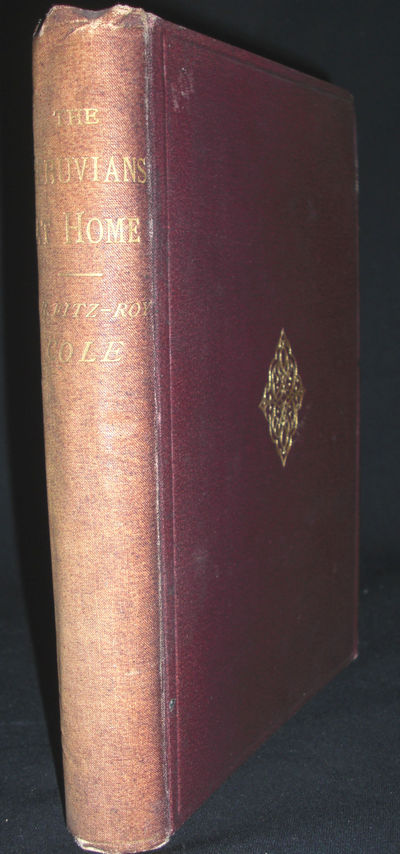
Fitz-Roy Cole, George R
The Peruvians at Home
London.: Kegan Paul, Trench and Company, 1884
- $1,500
London. Kegan Paul, Trench and Company 1884 Bound in original publisher's pictorial gilt decorated burgundy cloth. 12mo. 5.5"x7.5 The First Edition. Slight lean. Covers mildly rubbed. Mild sunning to spine. Small previous owners rubber stamp to front pastedown. Light water stain to rear free endsheet ( not intruding further into text block). A Very-Good copy. An extremely rare Title, with no other extant copies presently noted.
More from Heldfond Book Gallery
Paxton, Sir Joseph.
Paxton's Magazine of Botany,and Register of Flowering Plants. London. Bradbury and Evans - Orr and Smith . All 8vo. (6.5" x 9"), with the exception of Vol. 16 at 6.75' x 9.75". Twelve volumes ( of Sixteen). 1834 - 1849. All First Edition Issues. Vol. 1 bound in 3/4 grain Morocco and marbled boards. Gilt ruled spine compartments with raised bands. Gilt titles. Vol. 16 bound in 3/4 grain Morocco. Gilt ruled spine compartments with raised bands. Gilt titles. Marbled endsheets. Remaining 10 Vols. bound in pictorial gilt decorated full grain Morocco. Decorative gilt-tooled fleural embellishments and further blind embossing to front and rear covers. Gilt titles and gilt-tooled decorative fleural embellishments to spines. All edges gilded. Gilt-tooled Turn-Ins. Marbled endsheets. 1: 1834 (t.p. date; viii: 20 Dec 1834), p. [i]-xii, [1]-278, 38 of 42 plates( lacking 4). 2: 1836 (p. viii: 20 Dec 1835), p. [i]-xii, [1]-270, [1-5, index], 43 plates (complete). 3: 1837 (p. viii: 20 Dcc 1836), p. [1]-viii [1-4, index], [1]-280, 43 plates(complete). 4: 1838 (p. viii: 20 Dcc 1837), p. [1]-xii, 1-279, 42 of 43 plates (lacking 1). 5: 1838 (t.p. date; p. viii: 20 Dec 1838), p. [i]-xii, [1]-280, 50 plates(complete). 6: 1839 (p. viii: 20 Dec 1839), p. [i]-xii, [1]-280, 48 plates (complete). 7: 1840 (p. viii: 20 Dec 1840), p. [1]-xii, [1]-280, 48 plates (complete). 8: 1841 (p. viii: 30 Dcc 1841), P. [i]-xii, [1]-280, 46 plates (complete). 9: 1842 (p. viii: 20 Dec 1842), p. [i]-xii, [1]-279, 48 plates (complete). 14: 1848 (p. viii: 20 Dec 1847), P. [1]-xii, [1]-280, 48 plates (complete). 15: 1849 (p. [vii]: 23 Dec 1848), P. [1]-xi, [I]-314, 48 plates (complete). 16: 1849 (p. 3: 12 Jan 1849), p. [i]-xii, [1]-376, 22 of 24 plates (lacking 2). (Vols. 10-13-lacking)The Battle of Leyte Gulf – A Gathering of Original Combat Despatches and Various Original Ephemera From History's Greatest Naval Battle.
16 Radio Telegrams including detailed Action Reports, Tactical Operation Commands, Battle Assessments, Damage Reports, etc. spanning the full duration of The Battle of Leyte Gulf, 24 October - 28 October 1944. Imprinted upon wartime, U.S. Communication Service (USS Hector - 20M Sets) yellow onionskin paper. 8" x 6.5". 7 designated "Secret- Urgent", 4 designated "Operational Priority-Secret", 2 designated "Priority-Secret", 1 designated "Top Secret-Operational Priority", 1 designated "Secret-Op-Op-Op",1 designated "Routine-Confidential". TRANSCRIBED DESPATCHES #240315 10/24/44 06;14 From: CTF 77-(Vice-Admiral Kinkaid--7th Fleet - King II Attack Force) Action: CTG 77.2 - (Rear-Admiral Olendorf - Bombardment & Fire Support Group) CTF 78 - (Rear Admiral Barbey - Northern Attack Force) CTF 79 - (Vice-Admiral Wilkinson - Southern Attack Force) CTG 77.3 - (Rear Admiral Berkey - Close Covering Group) CTG 70.1 -( Commander S.S. Bowling - MTB Group) PREPARE FOR NIGHT ENGAGEMENT X ENEMY FORCE ESTIMATED 2 BB 4 CA 4 CL 10 DD REPORTED UNDER ATTACK BY OUR CARRIER PLANES IN EASTERN SULU SEA AT 09101 24 OCT X ENEMY CAN ARRIVE LEYTE GULF TONIGHT X MAKE ALL PREPARATIONS FOR NIGHT ENGAGEMENT X TG 77.3 ASSIGNED TO CTG. 77.2 AS REINFORCEMENT X CTG 70.1 STATION MAXIMUM NUMBER PT'S LOWER SURIGAO STRAIT TO REMAIN SOUTH OF 10-10N DURING DARKNESS. #240504 10/24/44 06:34 From: CTG 70.1 - (Commander S.S. Bowling - MTB Group) Action: All TFC 7th Fleet All TGC 7th Fleet AGP 8 Wachapreague EXPECT TOKYO EXPRESS TONIGHT X BEFORE DARK STATION BOATS IN SECTIONS OF 2 OR 3 BOATS EACH AT FOLLOWING POSITIONS X SOUTHWEST TIP PANOAN X SOUTH OF MADILAO POINT X SOUTH OF LIMASAWA ISLAND X 2 SECTIONS PATROL BETWEEN AGIO POINT BOHOL PAST CAMIGUIN ISLAND TO SEPACG POINT MINDANAO X VITAL EASC OSTOKOWSW FILE REPORT CONTACTS AND THAT OTHER SECTION LEADERS AND WACHAPREAGUE RELAY THESE REPORTS TO CODLIVER X 21 BOATS FROM OYSTER BAY STATIONED BY SECTIONS AS FOLLOWS x SOURGDB T TIP PANOAN ISLAND X BILAA POINT MINDANAO X IN SURIGAO STRAIT 5 SECTIONS X 1 OFF SUMILON ISLAND X 1 MEDCHANTRN OFF KANHATID POINT DINAGAT ISLAND X 2 OFF KANIHALN ISLAND X 1 SOUTHEAST AMAGUSAN POINT X WACHAPREAGUE INFORM LCIS LAST STATION X SECTIONS ATTACK INDEPENDENTLY AFTER MAKING CONTACT REPORT X CTG 70.1 SENDS. #240938 10/24/44 From: CTG 77.4 - ( Rear Admiral T. L. Sprague - Escort Carrier Group - CarDiv22) Action: CTG 77.4 THE SUPERB AIRMANSHIP AND FIGHTING SPIRIT DISPLAYED TODAY WILL LIVE IN HISTORY X IT IS MY OPINION THAT THIS IS THE FIRST DAY OF A RUNNING FIGHT WHICH WILL MARK THE ECLIPSE OF JAPANESE SEA POWER x TO BE EQUAL TO THE TASK IS ONLY TO REPEAT WHAT YOU HAVE DONE TODAY X UNIT COMMANDERS PASS TO THOSE UNDER YOUR COMMAND. #242232 10/25/44 From: CTG 77.4 - ( Rear Admiral T. L. Sprague - Escort Carrier Group - CarDiv22) Action: CTF 77 ( Vice-Admiral Kinkaid--7th Fleet - King II Attack Force) CTF 78 (Rear Admiral Barbey - Northern Attack Force) CTF 79 (Vice-Admiral Wilkinson - Southern Attack Force) All CTG's TF 77 (King II Attack Force) COMPLETE REPORT OF ESCORT CARRIERS OPERATIONS TWENTY FOUR OCTOBER X ENEMY AIR RAIDS IN FORCE CAUSED CANCELLATION OF VISAYAS STRIKES AND SOME REDUCTION OF SUPPORT AIRCRAFT X OUR REINFORCED COMBAT PATROL SHOT DOWN FORTY EIGHT TWIN ENGINE AND EIGHTEEN SINGLE ENGINE JAP PLANES PLUS EIGHT MORE TWIN ENGINE PLANES PROBABLY DESTROYED IN A WILD MELEE OVER LEYTE ISLAND THE BEACHES AND SHIPPING IN LEYTE GULF X PLANES SHOT DOWN INCLUDED TWENTY LILYS, EIGHTEEN SALLYS, SEVEN FRANCES, AND WIDE ASSORTMENT OF OTHER ARMY AND NAVY TYPES X HIGH SCORE FOR THE DAY WAS MADE BY LT CDR FUNK OF SANTEE WITH FIVE KILLS ON A SINGLE FLIGHT WHILE SAWANNEE PILOTS REPORTED KNOCKING DOWN EIGHT OUT OF EIGHT IN ONE GROUP X OUR LOSSES IN COMBAT WERE TWO PILOTS AND EIGHT PLANES WHICH INCLUDED ONE FOX SIX FOX FOUR FOX MIKE TWO TARE BAKER MIKE PLUS ONE FOX MIKE MISSING X OPERATIONAL LOSSES WERE ONE FOX MIKE WHICH SPUN IN JUST AFTER TAKEOFF DURING DARKNESS WITH THE LOSS OF THE PILOT X SPECIAL STRIKE ON BACOLOD FIELD DESTROYED TWO IRVINGS, ONE KATE, ONE BETTY, AND ONE SINGLE ENGINE PLANE ON THE FIELD, DAMAGED ONE IRVING AND ONE TOJO, AND SANK ONE LUGGER AND FOUR BARGES X ONE JUDY CAME OUT TO FIND OUT WHAT WE WERE DOING OUTSIDE WAS CHASED FROM FIFTEEN THOUSAND TO FIFTY FEET AND SHOT DOWN BY THE LLERT LOCAL CAP X ALL IN ALL A GRAND DAY X FROM COMTASKFBBUP SEVENSEVEN DOT FOUR. #242348 10/25/44 01:07 From: COM 3RD FLT - ( Admiral Halsey -Commander 3rd Fleet) Action: CTG 38.1 - (Vice-Admiral John McCain) PROCEED AT BEST POSSIBLE SPEED TO SOUTHWEST STRIKE EARLIEST POSSIBLE ENEMY FORCE REPORTED TO BE 4 BB'S8 CA'S PLUS DD'S IN VICINITY11-20N 127-00E AT 0800 X FROM COM 3RD FLT ACTION CTG 38.1 INFO ALL TGC'S 3RD AND 7TH FLTS CTF 77 ALL TFCS 3RD AND 7TH FLTS. #250615 10/25/44 07:08 From: CTU 77.4.3 - ( Rear Admiral G.A.F.("Ziggy") Sprague -Escort Carrier Group - CarDiv 25) Action: CTG 77.4 - ( Rear Admiral T. L. Sprague - Escort Carrier Group - CarDiv22) SECOND BATTLE DAMAGE REPORT X KALININ BAY RECEIVED 15 SHELL HOLES IN HULL IN ADDITION TO A FEW SMALL FRAGMENTATION HOLES X MOST HOLES PLUGGED UP AND ONLY LEAKING SLIGHTLY NOW X NUMEROUS HOLES IN FLIGHT DECK BY SUICIDE PLANE BEING REPAIRED X AT01L FLOODED BUT UNDER CONTROL X SMALL FIRE IN FUEL OIL TANK UNDER MACHINE SHOP X GYRO OK BUT HAVING GREAT DIFFICULTY STEERING X ELEVATOR LOWERED AND DECOMMISSIONED X ALL COMMUNICATIONS ON BRIDGE OUT X CAN RECEIVE VHF ONE CANNOT TRANSMIT ON ANYTHING NO RADAR X CANNOT STAND ANY INCREASE IN DRAFT XX 1020 HOEL REPORTED STOPPED TO PLUG HOLE 6 FEET IN DIAMETER 2 FEET BELOW WATERLINE X ONE GUN OUT X SOUND GEAR OUT X 200 ROUNDS OF AMMO LEFT NO TORPEDOES X NOT HEARD FROM SINCE X KITKUN BAY DAMAGE TO SHIP NEGLIGIBLE FROM NEAR BOMB HIT AND CRASH OF ENEMY PLANE X ONE KILLED 16 WOUNDED. #260139 10/26/44 06:05 (?) From: CTF 77 - ( Vice-Admiral Kinkaid--7th Fleet - King II attack Force) Action: None Information: CTF 38 - (Vice Admiral Mitscher - Fast Carrier Forces) COMAF 5 - ( Lt. General Ennis C Whitehead) COMFEAF - (General George Kenney) ENEMY CRUISER AND FIVE DD PROCEEDING COURSE 300 FROM BULALAOUI POINT NORTH CEBU X SHIPS 1000 POSITIONS FROM 5 TO 45 MILES NORTH CEBU X CRUISER IN VAN X CVE STRIKE NOW IN PROGRESS BUT ADDITIONAL STRIKES NEEDED. #260427 10/26/44 04:55 From: CTF 77.4 - ( Rear Admiral T. L. Sprague - Escort Carrier Group - CarDiv22) Action: CTF 77 - ( Vice-Admiral Kinkaid--7th Fleet - King II attack Force) UNDER AIR ATTACK X SUWANNEE HIT BY SUICIDE DIVE FORWARD OF BRIDGE X FIRE UNDER CONTROL. #260551 10/26/44 06:07 From: CTF 77.4 - ( Rear Admiral T. L. Sprague - Escort Carrier Group - CarDiv22) Action: CTF 77 - ( Vice-Admiral Kinkaid -7th Fleet - King II attack Force) RECOMMEND ESCORT CARRIERS BE RETURNED TO MANUS IMMEDIATELY DUE SHORTAGE FUEL BOMBS TORPEDOES AND LOSS YESTERDAY OF ABOUT TOTAL OF 130 PLANES X DETAILS IN MESSAGE FOLLOWING. #260631 10/26/44 16:24 From: CTF 77 - ( Vice-Admiral Kinkaid--7th Fleet - King II attack Force) Action: COMINCH (Admiral Ernest King - Commander-In-Chief, U.S. Fleet) Information: CINCSWPA ( General Douglas Macarthur - Commander U.S. Forces Far East) CINCPOA ( Admiral Chester Nimitz - Commander-In-Chief Pacific Fleet) COM3RDFLEET ( Admiral Halsey -Commander 3rd Fleet) COMA/RPAC (Vice-Admiral John Hoover - Task Force 57 - Forward Area Central Pacific) COM7THFLEET ( Vice-Admiral Kinkaid -7th Fleet - King II Attack Force) WITH THE DEEPEST REGRET ITEM REPORT THE LOSS OF 2 CVE'S 2 DD'S AND 1 DE PLUS DAMAGE TO OTHER SHIPS IN A BATTLE FOUGHT TO THE EASTWARD OF SAMAR ON 25 OCT BETWEEN ENEMY AIR AND SURFACE FORCES AND A GROUP OF 16 CVE'S PLUS DD AND DE ESCORTS X THIS GROUP WITH SUPERB DETERMINATION AND SKILL FOUGHT AND DEFEATED A STRONG ENEMY SURFACE FORCE SUPPORTED BY REPEATED ATTACKS BY SHORE BASED ENEMY AIRCRAFT X THEY STRUCK REPEATEDLY WITH ALL MEANS AT THEIR DISPOSAL UNTIL THE ENEMY RETIRED DEFEATED AND CONTINUED TO STRIKE HIS RETREATING FORCES UNTIL DARKNESS X THE REPORT OF THE VALLIANT COMMANDER OF THIS GALLANT GROUP REAR ADMIRAL T.L. SPRAGUE IS TRANSMITTED HEREWITH X QUOTE X CTG 77.4 DESPATCH 25_00 X AS A RESULT OF TODAY SURFACE AND AIR ACTIONS CTU 77.4.3 REPORTS SAINT LO (FORMER MIDWAY) HIT BY DIVE BOMBER FOLLOWED BY HEAVY EXPLOSION WHICH DESTROYED SHIP X GAMBIER BAY JOHNSON AND ROBERTS MISSING SINCE BOMBARDMENT BY STRONG ENEMY FORCE BELIEVED TO CONTAIN 4 BB 8 CA AND CL 7 OR MORE DD ALL VERY FAST X ALL CARRIER GROUPS WERE UNDER ATTACK THROUGHOUT THE DAY X SANTEE RECEIVED TORPEDO HIT AND SUICIDE CRASH ON DECK WHICH STARTED FIRE AND PENETRATED BOTH FLIGHT AND HANGAR DECK X SANGAMON HAD SUICIDE CRASH ALONGSIDE WHICH PUNCTURED SIDE IN MANY PLACES X FIRES AND DAMAGE WERE BROUGHT UNDER CONTROL AND ALL VESSELS CONTINUED TO LAUNCH STRIKES AGAINST ENEMY FORCE TILL SUNDOWN X VESSELS OF TU 77.4.2 WERE UNHIT UP TO LATE AFTERNOON AND THIS GROUP LAUNCHED A TOTAL OF 6 HEAVY STRIKES ARMED WITH TORPEDOES AND HEAVY BOMBS X NORTHERN GROUP TU 77.4.3 WAS UNDER MORE OR LESS CONTINUOUS FIRE OF ENEMY BATTLESHIPS CRUISERS AND AIRCRAFT THROUGHOUT THE DAY X ALL SURVIVING CARRIERS WERE DAMAGED X WHITE PLAINS FANSHAW BAY AND KITKUN BAY GOT FIRES AND OTHER DAMAGE UNDER CONTROL AND CONTINUED TO LAUNCH ATTACKS UNTIL THE END OF THE DAY X LAST STRIKES FROM ALL SHIPS WERE OVERTAKEN BY DARKNESS AND MANY LANDED ON LEYTE X DAMAGE TO ENEMY CANNOT BE ASSESSED AT PRESENT BUT UNKNOWN DAMAGE INCLUDES 4 TORPEDOES IN BB AND NATORI CLASS CRUISER STOPPED AND SET AFIRE IN MINDANDO SEA X OFF SAMAR 2 BB WERE HIT BY TORPEDOES AND ONE CA STOPPED DEAD X DD AND DE OF SCREEN TU 77.4.3 MADE A GALLANT HEAD ON ATTACK WITH GUNS AND TORPEDOES WHEN THE CARRIERS WERE BROUGHT UNDER FIRE BY THE ENEMY BB X CASUALTIES OF SUNK AND MISSING SHIPS CANNOT BE ESTIMATED X THERE WERE 40 DEAD AND 40 CRITICALLY WOUNDED ON SANTEE X ONE DEAD ON SANGAMON X ONE DEAD ON ROWELL X REPORTS FROM OTHER TASK UNITS ARE NOT YET AVAILABLE X RICHARD S BULL AND EVERSOLE WERE ORDERED TO SCENE OF SINKING TO RECOVER SURVIVORS REPORTED IN WATER X REPORT ON SINKING RECEIVED TOO LATE TODAY BUT SEARCH WILL BE CONTINUED ASSISTED BY AIRCRAFT TOMORROW X DURING RETIREMENT COOLBAUGH GOT WHAT IS BELIEVED TO BE A SUB (11 GROUPS MISSED) X SHE WAS ORDERED TO SIT ON HER CONTACT THROUGHOUT THE NIGHT X THE SPROSTON ALSO HAD GOOD CONTACT AND HAS SIMILAR ORDERS X SPROSTON SHOT DOWN ONE NIGHT RAIDER WHICH WAS ATTEMPTING TO ATTACK TU 77.4.3 X NO ESTIMATE OF TOTAL AIRCRAFT SHOT DOWN CAN BE MADE AT THIS TIME BUT THE NUMBER IS CONSIDERABLE X FIRST STRIKES OF THE DAY WERE WITH THE ENEMY ON A WESTERLY COURSE TO SAN BERNARDINO STRAIT UNQUOTE X THIS ACTION AND THAT OF THE PRECEDING NIGHT IN WHICH STRONG ENEMY SURFACE FORCES WERE OVERWHELMINGLY DEFEATED IN SURIGAO STRAIT BY OTHER SURFACE UNITS OF THE 7TH FLEET UNDER REAR ADMIRAL RALP B OLENDORF ARE HIGHLIGHTS ON THE ROAD TO TOKYO X TOGETHER THEY CONSTITUTE THE BATTLE OF LEYTE GULF. #261131 10/26/44 16:53 From: CTF 77 - ( Vice-Admiral Kinkaid -7th Fleet - King II attack Force) Action: CTF 77.4 ( Rear Admiral T. L. Sprague - Escort Carrier Group - CarDiv22) Information: All TGC & TFC 3rd and 7th Fleets ESSENTIAL THAT SIX OF YOUR CARRIERS REMAIN THIS AREA IF AT ALL POSSIBLE TO PROVIDE FIGHTER COVERAGE REFERRING YOUR 260614 x DESIGNATE SIX THAT ARE IN BEST OPERATING CONDITION TO REMAIN X FILL THEM WITH FIGHTERS RETAINING ONLY SUFFICIENT VT FOR YOUR OWN ASP X SEND REMAINING CVE's TO MANUS WHEN TRANSFER OF PLANES EFFECTED X GROUP REMAINING WILL BE FUELED ACCIPITER 28 OCTOBER X CTF 77 SENDS. REF ATTACHED. #262355 10/27/44 09:43 From: CTU 77.4.3 - ( Rear Admiral G.A.F.("Ziggy") Sprague -Escort Carrier Group - CarDiv 25) Action: CTF 77 ( Vice-Admiral Kinkaid--7th Fleet - King II attack Force) CTG 77.4 - ( Rear Admiral T. L. Sprague - Escort Carrier Group - CarDiv22) Information: COMINCH - COMINCH (Admiral Ernest King - Commander-In-Chief, U.S. Fleet) CINCPAC - ( Admiral Chester Nimitz - Commander-In-Chief Pacific Fleet) COMAIRPAC -(Vice Admiral George Murray - Commander, Air Force, Pacific Fleet ) COM3RDFLT - ( Admiral Halsey -Commander 3rd Fleet) COM7THFLT - ( Vice-Admiral Kinkaid -7th Fleet - King II Attack Force) CINCSOWESPAC - ( General Douglas Macarthur - Commander U.S. Forces Far East) NPM PASS TO COMINCH CINCPAC COMAIRPAC FOR INFO X MAIN ENEMY BODY SIGHTED BY ASP AS PER MY CONTACT REPORT AT 0603 ITEM OCT 25 X FOR OVER 2 1/2 HOURS THIS FORCE WAS SUBJECTED TO ENEMY BB, CA, AND DD GUN AND TORPEDO ATTACK X WE WERE HIT NUMEROUS TIMES X GAMBIER BAY HAD ONE ENGINE PUT OUT OF COMMISSION DROPPED BACK AND MUST HAVE BEEN SUNK BY ENEMY GUNFIRE PLUS HOEL JOHNSTON AND ROBERTS X REMAINING 5 CVE EMERGED FROM THIS DAMAGED BUT ABLE TO MAINTAIN 16 KNOTS X ABOUT 1 HOUR 20 MINUTES LATER 6 SUICIDE BOMBERS ATTACKED X ATTACK HAD TO BE SEEN TO BE BELIEVED X 3 PLANES HIT BY AA NARROWLY MISSED SHIPS X 1 HIT PORT CATWALK OF KITKUN BAY X 1 SKIDDED LENGTH OF KALININ BAY FLIGHT DECK OVER BOW X 1 WENT THROUGH DECK OF SAINT LO WHICH SHORTLY BLEW UP X PRELIMINARY REPORTS FROM SUCH OF OUR PILOTS AS ARE IN COMPANY SHOW FOLLOWING DEFINITE DAMAGE BY OUR PLANES X 1 CA SEEN TO BLOW UP AND SINK X 1 CA HIT BY 2 TORPEDOES AND 20 MINUTES LATER OBSERVED ON ITS SIDE X 3 MORE CA TORPEDOED X 1 BB DAMAGED X THE REST GOT AWAY X THIS UNIT TOGETHER WITH PLANES OF TU 77.4.1 AND 77.4.2 TURNED BACK ENEMY FLEET BEFORE ANY OTHER OFRENBURCPNAO COUOD ATTACK X 3 REMAINING SHIPS OF MY DIVISION REQUIRE EXTENSIVE NAVY YARD REPAIRS BEFORE COMBAT DUTY X PRELIMINARY REPORT OF CASUALTIES OF SHIPS NOW WITH ME X 10 KILLED 59 WOUNDED X I UNDERSTAND 800 SANIT LO SURVIVORS HAVE BEEN PICKED UP X DETAILED REPORT LATER. #270122 10/27/44 03:45 From: CTG 77.4. - ( Rear Admiral T. L. Sprague - Escort Carrier Group - CarDiv22) Action: CTF 77 ( Vice-Admiral Kinkaid--7th Fleet - King II attack Force) FOR ADMIRAL KINKAID x I DEEPLY REGRET THE EMBARRASSMENT WHICH MY 260614 MUST HAVE CAUSED YOU X YOUR 261328 HAS RELIEVED MY ANXIETY FOR MY SHIPS WHICH HAVE DEMONSTRATED A HOPELESS DEFENSE AGAINST THE CURRENT TECHNIQUE OF SUICIDE DIVES X MY RECOMMENDATION WAS BASED ON ERRONEOUS INFORMATION THAT THE AIR CORPS HAD ARRIVED X SPRAGUE #271147 10/28/44 00:40 From: CTF 77 ( Vice-Admiral Kinkaid--7th Fleet - King II attack Force) Action: COMINCH - ( Admiral Ernest King - Commander-In-Chief, U.S. Fleet) Information: CINCSWPA - ( General Douglas Macarthur - Commander U.S. Forces Far East) CINCPAC - ( Admiral Chester Nimitz - Commander-In-Chief Pacific Fleet) COM3RDFLT - ( Admiral Halsey -Commander 3rd Fleet) COM7THFLT - ( Vice-Admiral Kinkaid -7th Fleet - King II Attack Force) All TFC & TGC 3rd and 7th Fleets ON THE 26TH CVE COVERING GROUP (TG 77.4) DESPITE BATTLE LOSSES SUFFERED FROM THE PRECEDING DAY CONTINUED TO COVER OUR FORCES IN THE LEYTE GULF AREA AND LAUNCHED STRIKES IN THE CAMOTES SEA X 1 ENEMY CL WAS HIT WITH 4-500 POUND BOMBS AND 1 TORPEDO AND 1 DD CONFIRMED SUNK AFTER STRAFING ATTACK BELIEVE IT OR NOT X OTHER ATTACKS AS YET UNREPORTED X ABOUT 1100 OUR CVES WERE ATTACKED BY ENEMY PLANES X AFTER COMBAT PATROL HAD SHOT DOWN 4 OF GROUP 8-12 PLANES NIPS BEGAN A SERIES OF SUICIDE DIVES X 3 SHOT DOWN BY SHIPS GUNFIRE X 1 LANDED ON FLIGHT DECK SUWANNEE AMONG PARKED PLANES X SEVERE DAMAGE TO SHIP AND PLANES X MANY PERSONNEL CASUALTIES NUMBER UNDETERMINED X DE ROWELL OF CVE GROUP ABOUT 0900 SIGHTED PERISCOPE AND ATTACKED X MUCH OIL AND DEBRIS KEPT RISING DURING THE DAY X CLAIMS SUNK X CTF 77 SENDS ACTION COMINCH INFO CINCSWPA CINCPAC COM3RDFLT COM7THFLT ALL TFC AND TGC 3RD AND 7TH FLEETS X CRUISER AND DESTROYER GROUP HAVING REPLENISHED FUEL AND AMMUNITION AFTER THE SURIGAO STRAIT ACTION IS NOW WITH CVE COVERING GROUP X FAST CARRIERS OF 3RD FLEET ARE NOW PROVIDING CLOSE SUPPORT OF LEYTE AREA X ENEMY AIR RAIDS CONTINUED TODAY BUT WITH REDUCED EFFECTS CONTRIBUTED TO THE EFFECTIVENESS 3RD FLEET FAST CARRIERS AGAINST THE ENEMY AIR FIELDS X MORE ACCURATE INFORMATION IS NOW AVAILABLE ON THE RESULTS OF THE NIGHT BATTLE OF SURIGAO STRAIT STARTING EARLY MORNING OF 25 OCTOBER X 05 THE ENEMY FORCE WHICH ATTEMPTED TO FORCE INTO LEYTE GULF VIA THE SURIGAO STRAIT 2 BB 2CA 2 CL AND 10 DD ONLY 1 CA 1 CL AND 4 DD GOT OUT THE WAY THEY CAME IN X 2 BB IDENTIFIED AS YAMASHIRO AND BUSO 1 CA 1 CL AND 6 DD WERE DEFINITELY SUNK BY THE COMBINED TORPEDO ATTACKS OF OUR PT'S SNF DD'S AND THE * *NOTE: REMAINDER OF MESSAGE (ABOUT 25 GROUPS) MISSED ON BOTH MANUS AND BELLS TRANSMISSIONS. #272207 10/28/44 01:08 From: CTF 77.4 ( Rear Admiral T. L. Sprague - Escort Carrier Group - CarDiv22) Action: CTF 77 ( Vice-Admiral Kinkaid--7th Fleet - King II attack Force) Information: TO WELCOME THE AIR CORPS CTF 78 (Rear Admiral Barbey - Northern Attack Force) CTF 79 (Vice-Admiral Wilkinson - Southern Attack Force) ALL TGC OF TF 77 OPERATIONS 27 OCTOBER X COMTASKGROUP 77.4 SENDS X BOTH OPERATING GROUPS WERE REINFORCED BY CRUISERS AND DESTROYERS TODAY AND ALL HANDS BREATHED EASIER TO SEE THE BRISTLING GUNS WHICH SPELL THE ONLY KNOWN REMEDY FOR THE REPEATED SUICIDE DIVES WHICH THE ESCORT CARRIERS HAVE EXPERIENCED X ONE FORMATION OF JAPS ATTACKED IN THE EARLY MORNING BEFORE THE RENDEZVOUS WITH THE CRUISERS BUT WERE BEATEN OFF BY SHIPS GUNFIRE X LATER ANOTHER GROUP OF BOGIES APPROACHED BUT WERE DRIVEN OFF WITH ONE SHOT DOWN BY CAP X SUWANNEE WAS SENT TO KOSSOL TO EVACUATE WOUNDED AND PROCEED MANUS X SANTEE WAS ORDERED TO PROCEED TO MANUS DIRECT X A REDUCED CAP OVER THE LANDING AREA SHOT DOWN 6 ENEMY PLANES AND PROBABLY GOT 3 MORE X 3 WERE SHOT DOWN BY THE CAP OVER THE FORCE WHILE 1 BETTY WAS DESTROYED AND 6 WERE DAMAGED ON LAHUG FIELD X THE LAST FLYABLE PLANES FROM THE LANDINGS OF THE NIGHT OF THE BATTLE OF LEYTE GULF WERE RECEIVED ABOARD X PLANES OF TU 77.4.3 HELPED TO REPLACE LOSSES OF THE OTHER GROUPS X ALL HANDS WERE DELIGHTED. #272351 10/28/44 02:00 From: COMPHIBGROUP 8 ((Rear Adm. W. M. Fechteler) Action: COMINCH - COMINCH (Admiral Ernest King - Commander-In-Chief, U.S. Fleet) CINCSWPA - ( General Douglas Macarthur - Commander U.S. Forces Far East) COM7THFLT - ( Vice-Admiral Kinkaid -7th Fleet - King II Attack Force) CTF 77 ( Vice-Admiral Kinkaid--7th Fleet - King II attack Force) COMCARDIVS 23, 25,& 26 - ( Commander, Carrier Divisions 23*, 25 - Rear Admiral G.A.F. Sprague, 26 - Rear Admiral Ofstie) CINCPAC - ( Admiral Chester Nimitz - Commander-In-Chief Pacific Fleet) SENIOR SURVIVOR CAPT VIEWIG NOW IN FREMONT REPORTS GAMBIER BAY SANK ABOUT 0900/I 25 OCTOBER IN LAT 12-30N LONG 126-30E AS RESULT ABOUT 20 8-INCH HITS FROM NIP HEAVY CRUISERS FINAL RANGE 2000 YARDS X COMPHIB GROUP 8 THROWS ACTION TO COMINCH CINCSWPA COM7THFLT CTF 77 COMCARDIVS 23, 25 AND 26 CINCPAC X NO COMPROMISE CLASSIFIED MATTER X 18 FIGHTERS AND 8 AVENGERS AIRBORNE AND PRESENT STATUS UNKNOWN X ABOUT 650 OFFICERS AND MEN RESCUED. * Cataloguers Note - No designation for CARDIV 23 appears in "Command Communication Manual for King II" ADDITIONALLY - 1. Communication Manual for King II. 86pps.4.5" x 5.5".Designated TOP SECRET with admonition - " THIS BOOKLET WILL NOT BE TAKEN ASHORE NOR CARRIED IN AIRCRAFT". Copy # 0157 and marked Flag Bridge, this is presumably Rear Admiral T. L. Sprague's copy whilst Commanding Taffy 1 Task Group aboard USS Sangamon during the Battle of Leyte gulf. 2. Propaganda Leaflet 2-J-1 - Japanese Soldier In A Rowboat.1944. 8.25" x 5.25". One of the earliest Army leaflets dropped on Japanese troops is 2-J-1 entitled “Japanese soldier sitting in a rowboat.” The U.S. did not want to antagonize the Japanese so they used a technique they call “soft-soaping” to point out their predicament without appearing to gloat. The leaflet depicts an unhappy Japanese soldier alone in a rowboat near a barren island. It appears that the 6th Army liked the leaflet so much that they reprinted it and used it in their section of the Philippines. The text on the front translates to: "Left Behind With Only Small Boats, an Army Chokes With Grief!" The back is all text and says in part: "Soldiers and Officers of Japan. We wish neither to insult nor make fun of you. Because at Bataan and Corregidor we faced the same miserable conditions you are now facing, we cannot but sympathize with you…Where are the ships that brought you and your supplies here? Where is the Navy which escorted your transports?When ships can no longer reach an island garrison, do you not realize for the first time that the island has been abandoned?" 3. Propaganda Leaflet - 2-F-1 MacArthur Has Returned.1944. 10.5" x 8" Notice that it is MacArthur that has returned and not thousands of American soldiers and sailors. Still, the General apparently believed that the Filipinos reacted to his own charisma and personality and perhaps he was correct. The two page bi-fold above shows MacArthur saluting on the front and debarking from an aircraft on the back. There are three black and white pictures of him inside the booklet. It appears that all the “F” leaflets were to the Filipinos after the American landing. The front of the leaflet depicts General MacArthur saluting. The back of the leaflet depicts the general stepping off an aircraft with the text: "General MacArthur steps out of a plane at an advance airbase somewhere in New Guinea." When the bi-fold is opened there are three black and white photographs inside the leaflet with MacArthur on a warship, walking down a Philippine road, and in a landing craft. The text is: "General MacArthur keeps his pledge. When General MacArthur left Corregidor, under orders from President Roosevelt to proceed to Australia and organize the offensive against Japan, his last words were “I shall return.” From that moment his one driving ambition has been to get back to the Philippines, to drive out the Japanese, and to restore the legitimate government of the Philippines. Today General MacArthur is back in the Philippines. He has returned as he promised. His great task is now entering its final phase. The forces under his command are assaulting the Japanese invaders throughout the Philippines. With these forces, General MacArthur will accomplish the liberation of the Filipino people. But that liberation can be accomplished more quickly, and at smaller cost to American and Filipino lives, with your help and co-operation. General MacArthur will tell you over the radio, in proclamation, and by leaflet, exactly how and when you can help. Watch closely for these instructions." 4. Propaganda Leaflet 3-F-1 - A Message to Every Filipino.1944. 8" x 5.5" This leaflet bears a Philippine seal on the front and a picture of the president on the back. This leaflet bears no code but my files show that it was 3F1. Some of the text is: President Osmena, elected to high office by the Filipino people at the last popular elections held in this country, has returned to the Philippines with General MacArthur. He and the members of his government, with the complete support and backing of the American government, come to assist in the restoration of your freedom. There is a photograph of President Osmena on the back in front of a CBS microphone addressing the Philippine people. The title is: "The Need for Unity". 5. Propaganda Leaflet 4-F-6 - The Yanks Have Landed On your Island.1944. "8.5" x 5.25". Leaflet depicts American soldiers walking ashore. It was prepared on 23 September 1944 to be used on islands where the Americans land from D-Day to D plus 5. The back text is in English and warns the Filipinos to stay away from Japanese military objectives and ends with: "Remember: Planes, bombs and shells cannot tell a friend from a foe." 6. Propaganda Leaflet 3-J-1 - Island Hopping.1944. 8.25" x 5.25". Army Psychological Warfare Branch leaflet 3-J-1 seems to be the first in a series of leaflets that depicts Japanese soldiers left behind as General MacArthur advanced using his "Island-Hopping" campaign. Other similar leaflets depicted a lone Japanese soldier standing on an island (6-J-1) or a lone Japanese soldier watching a battle take place on a nearby island (22-J-1). These leaflets all had the basic same message. You are cut off and there will be no resupply. There will be no food, no water, no ammunition and no reinforcements. Some of the text on this leaflet is: "Before you reach this miserable state, which is more than men ought to endure so far from home, we want you to keep something in mind. Those who choose to come to an honorable understanding with us will find that we treat them as human beings, not as enemies. We shall hold it a duty to see that they gave clothing food, shelter and medical care." This leaflet does not ask the Japanese soldier to surrender. To save face, it simply asks that he reach an "honorable understanding" with the Americans. 7. Propaganda Leaflet 1(b)J1 - I Surrender.1944. 9.5" x 13" Leaflet with English text on front and Japanese text on reverse. Some of the message is: "Officers and Soldiers of Japan The battle you have put up has our sincere respect. We are quite confident, however, that victory will be ours, as in past operations. We have this confidence because of our officers and men, our superior scientific equipment, our artillery and our bombing. When you left home, many thousands of miles away, you thought the Japanese would win. You have since learned that your planes and equipment are no match for those of the Allied forces. Through the operations of our Air Force and navy, air and sea supremacy on the Pacific south of Taiwan belongs to us. Because of this, it is impossible to move raw materials of military importance from the South Seas to Japan. Therefore, what is needed on the front line is lacking. For the same reason, the very moving of supplies to the front line is difficult. We take it for granted, therefore, that you know you have no hope of winning. It is clear that your plight is not your fault but the fault of the army and navy staffs. With the battle hopeless, what can you do? You can come to an understanding with our forces and preserve yourself for the rebuilding of Japan. That was what Japanese officers and men on Guadalcanal and New Guinea did. They realized the futility of bloodshed and came to an understanding with us for the sake of their country after the war…." (Propaganda leaflet research and cataloging by- SGM Herbert A. Friedman (Ret.) The United States PSYOP Organization in the Pacific during World War II.) 8. Plan of the Day-U.S.S. Sangamon- for Tuesday, 31 October 1944.Marked "Restricted".1 page Ship's Schedule, listing activities 0435 - 1800 hours to front page. Reprinting of 3 congratulatory Radio despatches from Battle Commanders (CINCPAC( Nimitz), Kinkaid, Sprague, ) to men participating in the Leyte Gulf Battle. 9. Radio Manus( NTF) Frequency Employment. Official Photograph. Chief of the Bureau of Aeronautics.15 August 1944.Chart depicting tree of radio frequencies disseminated throughout Radio Manus Control. Stamped "Confidential" to front and rear. Marked "CVE. 26" (USS Sangamon) in ink to rear. 8" x 10.5". 10. Aircraft Radio Frequency Tables and Air Ground Liaison. Official Photograph. Chief of the Bureau of Aeronautics.15 August 1944.Stamped "Confidential" to rear.Stamped USS Sangamon to rear.8" x 10.5". 11. Frequency Chart Task Force 78. Associated Ships and Commands. Appendix I Annex C. n.d. (1944).Stamped "Confidential" to rear. Chart detailing frequency distributions to ships and commands of Task Force 78 (Northern Attack Force) commanded by RearAdmiral Daniel Barbey at the Leyte Gulf Battle. 8" x 10.5". 12. Army Air Force Cloth Chart - Philippine Series.No. C-40, Luzon Island.Army Air Force Cloth Map - Asiatic Series. No. 34, Southeast China. Folding, 2 sided limp cloth.1944. 20.5" x 27". 2 copies. 13. Army Air Force Cloth Map. No. 20, Ambonia. No.21, Halmahera. Folding, 2 sided limp cloth. 1944. 28" x 34" . Sporadic Light Foxing. 14. Royal Australian Air Force Silk Map.Halmahera. n.d. (c.1944). 31" x 23" Radiograms are beyond Very Good with crisp texture and highly legible text. King II Communication Manual presents wear and soiling to covers, as expected. Staples rusted. Some sporadic usual soiling to internals. A Very Good, nicely preserved copy. Very Good "I Surrender" propaganda leaflet presents a 1 inch, nonintrusive split along mid-line fold crease. All other leaflets Near Fine. Radio Frequency Tables all Near Fine. Cloth and Silk maps present standard creasing from folding. All Fine and bright. Ship's schedule presents repairs to chipped and folded edges with polyethylene adhesive tape. Delicate but, Very Good. Radiograms are beyond Very Good with crisp texture and highly legible text. King II Communication Manual presents wear and soiling to covers, as expected. Staples rusted.Some sporadic usual soiling to internals. A Very Good, nicely preserved copy. Very Good "I Surrender" propaganda leaflet presents a 1 inch, nonintrusive split along mid-line fold crease. All other leaflets Near Fine. Radio Frequency Tables all Near Fine. Cloth and Silk maps present standard creasing from folding. All Fine and bright. Ship's schedule presents repairs to chipped and folded edges with polyethylene adhesive tape. Delicate but, Very Good. Full Photos of this collection may be found at: http://www.heldfond.com/pages/books/8860/the-battle-of-leyte-gulf-a-gathering-of-original-combat-despatches-and-various-original-ephemeraWessex Tales. Stange Lively and Commonplace
London. Macmillan & Co. 1888. Bound in original Publisher's Green cloth. Horizontal imprinted lines to front cover. Gilt tiled spines. Publisher's imprinted device to rear covers. Housed in Custom Slipcase with gilt titled Morocco label and further in custom chemise. 8vo. 5" x 7.5 The First Edition.One of only 750 copies,of which only 634 were bound up. All required points present in this copy. Purdy- p.58; Sadleir-1119 Hardy's first published collection of stories. Both volumes are mildly cocked. covers and spines. present mild, rubbing and darkening. Several short and mild wrinkles to cloth of Front Cover Vol. 1. Foxing to prelims.Several edges trimmed short.Text clean and bright with firm, uncracked hinges. A Very Good Set.Shapes of Clay
San Francisco W.E.Wood 1903. Fabulously bound in the Art Nouveau style by Pictorial Gilt and Lavender decorated green cloth over boards. Pictorial gilt vignette of a nude and gilt titles to spine. Top edge gilded. 8vo. First Edition, Second Issue. Illustrated by a photographic Frontis of the Author. A diverse and thorough collection of Bierce's later Verse. The mildest of rubbing to front cover. A bright, tight and supremely Fine copy.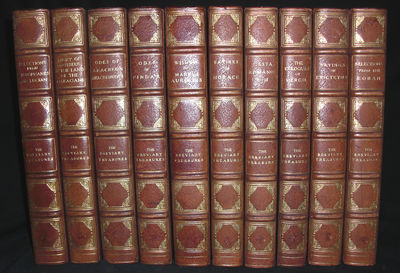
The Breviary Treasures
Boston Nathan Haskell Dole 1904 Handsomely bound in gilt ruled 3/4 brown Levant Morocco and linen covered boards. Elaborate gilt tooled spine compartments with gilt scored raised bands.Gilt titles. Top Edges Gilded. Tall 8vo. 6.5"x9". The Adelphi Edition. Number 171 of an Edition Limited to 475 copies, printed upon French Handmade paper. Illustrated by monochrome frontispieces and elaborate border decorations to each page of text. Sets is comprised by- The Wisdom of Marcus Aurelius. Translated by Jeremy Collier; The Ecolgues of Vergil. Translated by Baron Bowen; Sayings of Epictetus. Translated by T.W. Rolleston; Selections from Gesta Romanorum. Translated by Rev. Charles Small; Odes of Anacreon Anacreontics and Other Selections from the Greek Anthology. Translated by n/a ; The Satires of Horace. Translated by Various Hands; The Story of Odysseus in the Land of the Phæacians, Being the Sixth and a Part of the Seventh Book of the Odyssey. Translated by Andrew Lang and Prof. Butcher; Selections from Aristophanes and Lucian. Translated by F.A. Paley; The Olympic and Pythian Odes of Pindar. Translated by Abraham Moore; Selections from the Koran of Mohammed. Translated by George Sale. Various very mild rubbing to covers.Several extremely mild chips to several caps. Small scuffs to several spines,including a short vertical streak to Koran spine. Some corners gently bumped. A gleaming, crisp and clean Fine set.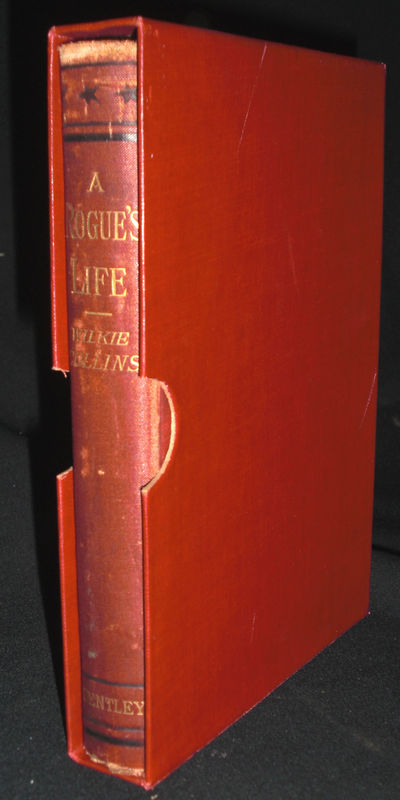
A Rogue's Life
London. Richard Bentley and Son. 1879. Bound in original Publisher's decorated and gilt tiled red cloth. In custom slipcase. 8vo. 4.5"x7". The First Edition. All appropriate points are present in this copy. Sadleir:604 , Parrish: Pg. 109. A Rogue's Life was originally published in Household Words during 1856. It was republished in book form in 1879 after an invitation from George Bentley 'to take a place in his new series of pretty volumes in red.' Collins made minor changes to the text and noted in some 'Introductory Words' that it was written 'at a very happy time in my past life...at Paris, when I had Charles Dickens for a near neighbour and a daily companion.' He also revealed that he had intended, but never written, a further series of the Rogue's adventures in Australia. The theme of picture forgery, and the character of Frank Softly, were probably inspired by Memoirs of a Picture, written by Collins's grandfather, William Collins Senior. The Scotch marriage of Frank and Alicia anticipates Collins's later attack on marriage laws in Man and Wife (1870)." Andrew Gasson - Wilkie Collins - An Illustrated Guide. Covers moderately soiled and rubbed. Very slightly rolled.Neat instance of prior spine crack repair at pg. 1. A crisp, Very Good copy.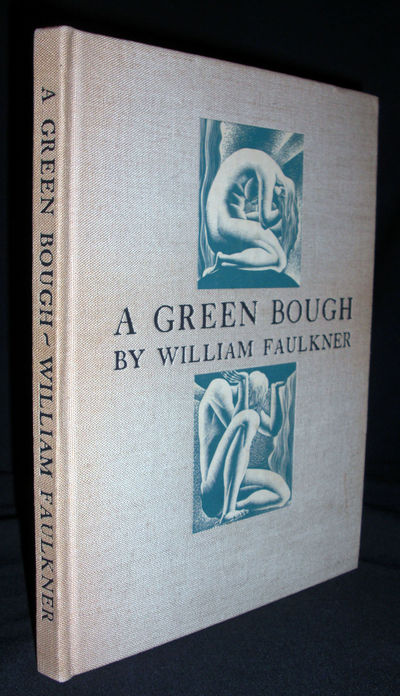
A Green Bough
New York. Harrison Smith and Robert Haas. 1933 Bound in wheat coloured linen over boards. Black titles. Decorated with two Lynd Ward vignettes to front cover. 8vo. 6.5" x 8.75". This Edition Limited to 360 copies, of which this is #241. Set in Janson type and imprinted upon Milano paper. Signed and numbered in ink by William Faulkner. Illustrated with woodblock engraved Art Deco vignettes in duotone by Lynd Ward. Faulkner published but two volumes of poetry during his lifetime, this being the final. Usual darkening to spine area (most common for this book). Moderate offset to front pastedown(blank) and front free endsheet(blank) most probably from an old paper insert. Else, a Fine, extremely bright and crisp copy of this exceedingly scarce issue.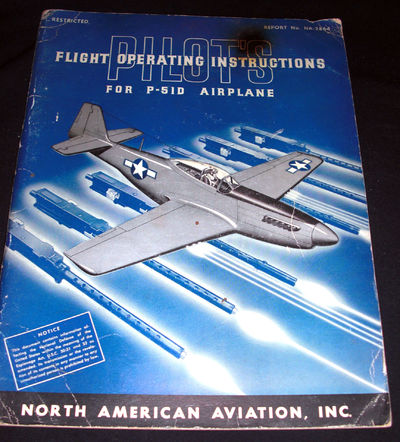
Pilot's Flight Operation Instructions for the P-51D Airplane
North American Aviation, Inc. 1944. Bound in stiff pictorial wrappers. Thin 4to. Classified "Restricted" and marked as such on each page. Report No. NA-5864. Profusely illustrated with photographs, drawings, maps, diagrams, charts, etc. The P-51 Mustang was,with little argument, the single greatest American Fighter Aircraft of World War 2. The sleek, low winged Mustang was among the very first to use a laminar-flow wing, which resulted in far less drag. Also, the P-51 had its wingtips, rudder, and elevators with square-cut ends, unlike almost every other aircraft at the time. It paid off, as the P-51 could reach 380mph while the lighter Spitfire, with half as much fuel weight, could not get within 15mph of that figure. The P-51 Mustang, designed in 1940 after Great Britain requested that North American build P-40 Warhawks for the Royal Air Force, was at first ignored by U. S. officials. However, the design showed such promise that in 1941 the Army Air Forces took delivery of P-51A's powered by the Allison V-1710 engine. These early Mustangs were restricted to reconnaissance and ground attack due to the limited performance of the Allison engines. Tests in 1942 with the Roll-Royce "Merlin" engine showed a marked increase in performance. By the end of 1943, Merlin powered P-51Bs entered combat with the 354th Fighter Group in England. Eighth Air Force Mustangs provided long range escort to B-17s and B-24s and scored heavily over German interceptors. By the war's end, P-51s had destroyed 4,950 enemy aircraft in the air, more than any other U. S. fighter in Europe. Mustangs served in nearly every active combat zone, including the Pacific where they escorted B-29s from Iwo Jima to Japan. Between 1941 and 1945, the Army Air Force ordered 14,855 Mustangs. During the Korean Conflict, P-51's were used primarily for close support of ground forces until withdrawn from combat in 1953. P-51s served with Reserve and National Guard units until 1957. Small blemish to front cover. Front and rear covers present various usual creasing and wear to edges. A patch or two of foxing to inside front cover.Small binding crease at top of gutter throughout. Several scattered annotations. A tad musty. A sound, crisp very rare wartime issue.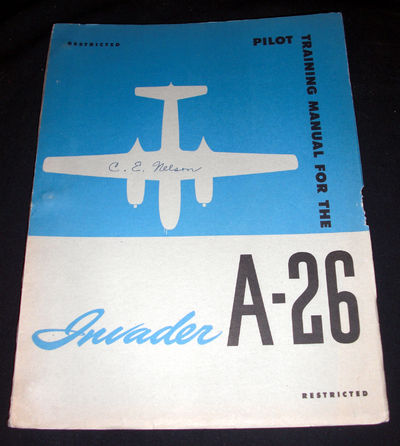
Pilot Training Manual for the A-26 Invader
Washington D. C. Headquarters-U.S. Army Air Forces. 1945. Punch and clipbound in stylized titled coloured pictorial wrappers. Thin 4to. Classified "Restricted" and marked as such on each page.The January 1945 issue. Profusely illustrated with photographs, drawings, maps, diagrams, charts, etc. The A-26, the last aircraft designated as an "attack bomber," was designed to replace the Douglas A-20 Havoc/Boston. It incorporated many improvements over the earlier Douglas designs. The first three XA-26 prototypes first flew in July 1942, and each was configured differently: Number One as a daylight bomber with a glass nose, Number Two as a gun-laden night-fighter, and Number Three as a ground-attack platform, with a 75-millimeter cannon in the nose. This final variant, eventually called the A-26B, was chosen for production. Upon its delivery to the 9th Air Force in Europe in November 1944 (and the Pacific Theater shortly thereafter), the A-26 became the fastest US bomber of WWII. The A-26C, with slightly-modified armament, was introduced in 1945. The A-26s combat career was cut short by the end of the war, and because no other use could be found for them, many A-26s were converted to JD-1 target tugs for the US Navy. A strange aircraft-designation swap occurred in 1948, when the Martin B-26 Marauder was deactivated and the Douglas A-26 was re-designated the B-26. (It kept this designation until 1962.) B-26s went on to serve extensively in both the Korean and Vietnam wars. In Vietnam, they were commonly used in the Counter-Insurgency (COIN) role, with very heavy armament and extra power. This version, the B-26K, was based in Thailand and was, to confuse things further, called the A-26 for political reasons. B-26s were also used for training, VIP transport, cargo, night reconnaissance, missile guidance and tracking, and as drone-control platforms. Post-war uses of the airplane included luxurious executive transport (Smith Tempo I; Tempo II and Biscayne 26; LAS Super-26; Berry Silver-Sixty; Monarch-26; On-Mark Marketeer/Marksman), aerial surveying and, most notably, firefighting, a role in which it is still occasionally used today. - warbirdalley Owners ink signature to front cover. Ink stamp of Salem Army Airdrome HQ dated 1945 to title Page and inside rear cover. Usual rust offset from metal binding pins to front and rear inside covers.2" shallow chip to fore-edge of front cover.An extremely bright and crisp, Near Fine copy of this original Second World War rarity.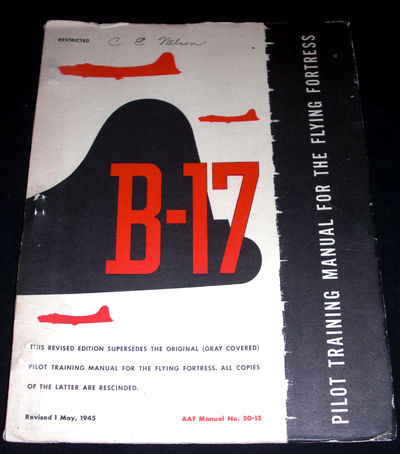
Pilot Training Manual for the B-17 Flying Fortress
Headquarters-U.S. Army Air Forces. Revised May 1945. Punch and clipbound in stylized titled coloured pictorial wrappers. Small 4to. Classified "Restricted" and marked as such on each page. Introduction by General Hap Arnold , Commanding General of the Army Air Forces Profusely illustrated with photographs, drawings, schematics, diagrams ( some fold-out ), cutaways, etc. Arguably the most famous aircraft of the Second World War the Boeing B-17 ( Flying Fortress ) was the spearhead of the American daylight bombing offensive in Europe from beginning to end , as well as serving in every other theatre of war. No single aircraft type contributed more to the defeat of the Luftwaffe, which enabled tangible expression to be given to the controversial U. S. policy for the strategic assault of Germany by day in the face of formidable political argument as well as desperate enemy opposition. Few other aircraft of the war gained the universal affection of their aircrew over so long an operational periods did the B-17 ( Green ). This manual served the dual purpose of training checklist and working handbook for B-17 pilot airplane commanders. Graphically intensive, the manual covers all aspects of the Flying Fortress from operational duties and command to construction, flight, navigation, weaponry, emergencies, etc. A very rare, highly prized memento of aviation and military. history Owners ink signature to front cover. Ink stamp of Salem Army Airdrome HQ dated 1945 to title Page and inside rear cover. Usual rust offset from metal binding pins to front and rear inside covers.Binding pin protruding slightly onto front cover. Mild sporadic soiling to rear cover.Light wear to edges. A crisp, bright Very Good copy of this original, rare relic of Aviation History.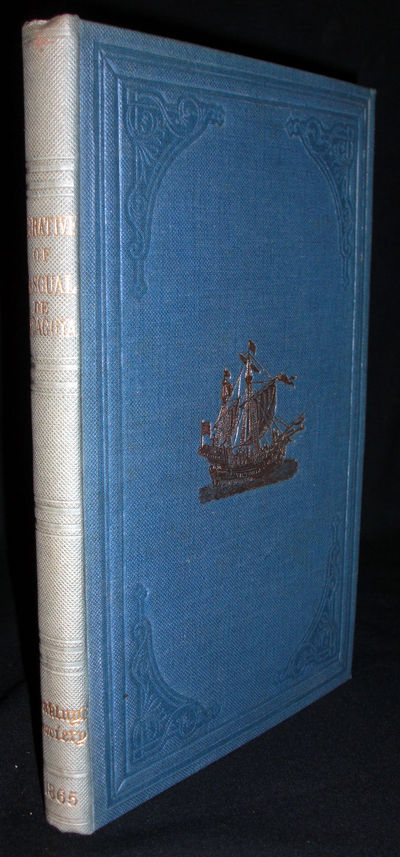
Narritive of the Proceedings of Pedrarias Davila in the Provinces of Tierra Firme or Castilla Del Oro, and of the Discovery of the South Sea and the Coasts of Peru and Nicaragua
London. The Hakluyt Society. 1865. Bound in pictorial gilt titled and decorated blue cloth. Blind embossed decorations to front and rear covers. 8vo. 6" x 9 The First Edition. Report of the Hakluyt Society for 1865 bound in to front. Illustrated by one hand colored folding map of The Isthmus of Panama. Very mild sunning to spine. Tiny, short marginal tear and very light crease to edge of map. Previous owners ink signature to front pastedown. Pages uncut. Light foxing to rear of free endsheet.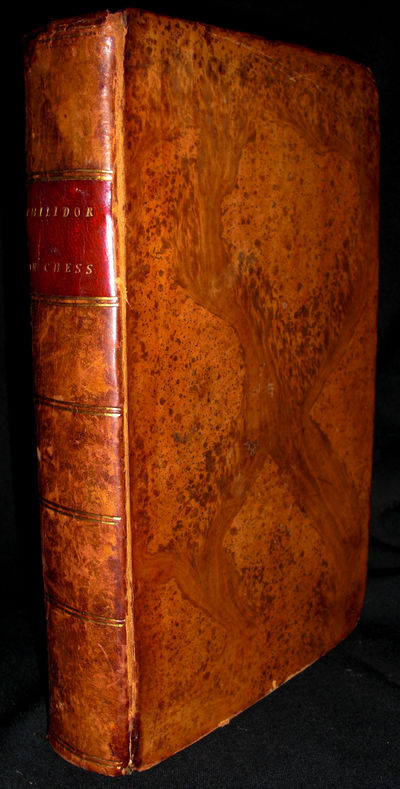
Studies of Chess: containing Caissa, A Poem, by Sir William Jones; a Systematic Introduction to the Game; and the Whole Analysis of Chess
London. Samuel Bagster. 1803. Handsomely bound in full period Tree Calf. Gilt ruled spine compartments. Red morocco,gilt title label. 8vo. 5.25"x8.5 The First Edition.Two Volumes in One. Complete as issued. Illustrated with a copperplate engraved Frontis of a chessboard and pieces. Rare First Edition of this early collection of writings on Chess and according to Hooper and Whyld (318) its chief merit is that it contains the whole of Philidor.The book also includes Sir William James's poem 'Caissa' while the introductory portion is from Peter Pratt's Theory of Chess. François-André Danican Philidor (1726-1795), was regarded as the best chess player of his age; his book Analyse du jeu des Échecs was a standard chess manual for at least a century,and is regarded as the most influential book on the modern game. A well-known opening and checkmate method are both named after him. Small repaired chip to headpiece. Some very sporadic offset, else a remarkably crisp and bright Fine copy of the exquisitely rare First Edition.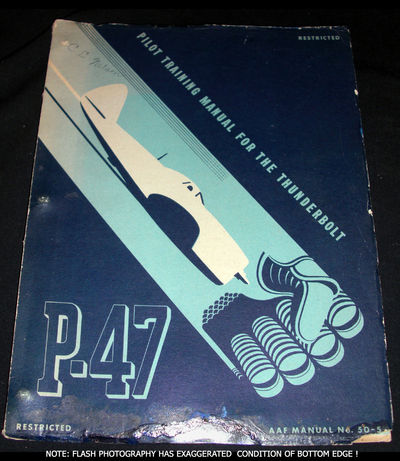
Pilot Training Manual for the P-47 Thunderbolt
Washington D. C. Headquarters-U.S. Army Air Forces. 1945. Punch and clipbound in stylized titled coloured pictorial wrappers. Thin 4to. Classified "Restricted" and marked as such on each page.The March 1945 issue.Laid-into this manual are two Fine pamphlets: 1. The Thunderbolt Pilot Speaks. Published by the A.C. of S.,A-2 Fighter Command. Marked "confidential".Undated but c. 1944. 2. Notes on the Use of Oxygen Equipment for Fighter Pilots -With Special Reference to the P-47. 46th Altitude Training Unit. Printed by the 1st Airborne EAUTC Reproduction Section. Undated, but c.1944. Profusely illustrated with photographs, drawings, maps, diagrams, charts, etc. The Thunderbolt was the most famous of all the Republic aircraft in WWII. First flown on 6 May 1941, the P-47 was designed as a (then) large, high-performance fighter/bomber, utilizing the large Pratt and Whitney R-2800 Double Wasp engine to give it excellent performance and a large load-carrying capability. The first deliveries of the P-47 took place in June 1942, when the US Army Air Corps began flying it in the European Theater. Though it was an excellent airplane, several improvements were made as production continued, with each improvement adding power, maneuverability and range. As the war progressed, the Thunderbolt, or "Jug," as it was affectionately called, gained a reputation as a reliable and extremely tough airplane, able to take incredible amounts of damage and still return its pilot home safely. P-47s logged almost 2 million flight hours during the war, during which they were responsible for the destruction of over 7,000 enemy aircraft in the air and on the ground in the European Theater alone. Later in the war, Jugs served as escort fighters for B-29 bombers in the Pacific. Mostly, though, they excelled in the ground-attack role, strafing and bombing their way across the battlefields of Europe. Early versions of the P-47 had "razorback" fuselages, but later models (beginning near the middle of the P-47D production run) featured a bubble canopy which gave the pilot increased rearward visibility. P-47s were also used during the war by the air forces of Brazil, England, France, Mexico and the Soviet Union. Following the war, the Jug served for nine more years in the US, flown by the Air National Guard. It continued to serve for many additional years with the air forces of over 15 nations around the world.- warbirdalley Owners ink signature to front cover. Ink stamp of Salem Army Airdrome HQ dated 1945 to title Page and inside rear cover. Usual protrusion of metal binding pins to front and rear inside covers. 2" chip to bottom corner of front cover. A 3.5" x .5" piece of front cover's bottom edge apparently was lacking and repair was conducted at sometime using a "filler" of like coloured card stock (which may be seen on the inside front cover). Spine and Edges sporadically and mildly worn.Small, mild stain to bottom of Title Page.Else, a crisp, bright Very Good copy.Strange Case of Dr. Jekyll and Mr. Hyde
Stevenson, Robert Louis New York., 1952. New York. Limited Editions Club. 1952. Bound in half morocco and paper covered boards. 4to. Limited Edition#1346 of 1500 copies. Illustrations by Edward A. Wilson. Signed by Wilson on the Limitation page. Scuffing and some wear to spine, else, Near Fine.- $50
- $50
Selected Papers on Anthropology, Travel & Exploration
Burton, Sir Richard New York., 1924. New York. Robert M. McBride and Company. 1924. Bound in cloth over boards with paper spine label.. 8vo. 6"x9 First U.S. Edition - bound from sheets of the First British Edition. Sporadic foxing throughout. A Very Good , crisp copy.- $110
- $110
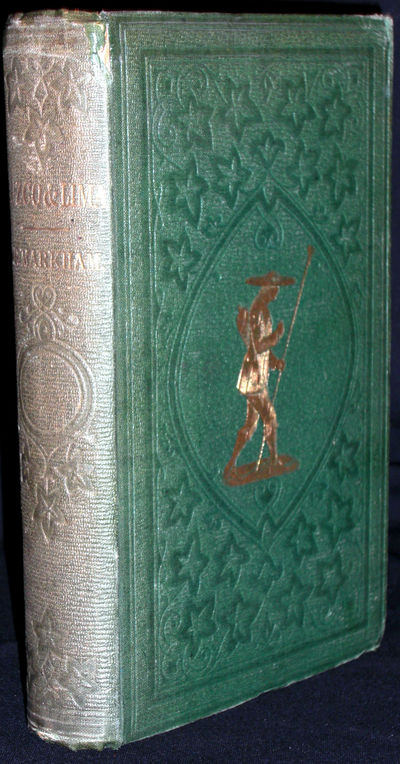
Cuzco: A Journey to the Ancient Capital of Peru; with an Account if the History, Language, Literature, and Antiquities of the Incas. And Lima: A Visit to the Capital and Provinces of Modern Peru; with A Sketch of the Viceregal Government, History of the republic, and a Review of the Literature and Society of Peru
London. Chapman and Hall. 1856. Bound in decorative blind embossed pictorial gilt decorated green cloth. 8vo. 5.25" x 8 The First Edition. Illustrated with 8 full paged Chromolithographs and a folding map. complete as issued. Several small chips to spine at gutters. Previous owners small stamps and ink signature to front blanks. A bit of foxing to blanks. Some marginal pencil annotations. Short marginal tear to folding map at gutter. A Very-Good, crisp bright copy.The Poems of Ossian. Translated by James Macpherson, Esq
Ossian London., 1807. London. Suttaby and Crosby. 1807. Handsomely bound in full tree calf. Gilt ruled spine compartments. Morocco labels. 8vo (5.5 in. x 8.5 in.). A superb collection of the poetical works of the renowned ancient Irish poet. Very mild rubbing to head and tailpieces. A handsomely bound, crisp set.- $350
- $350
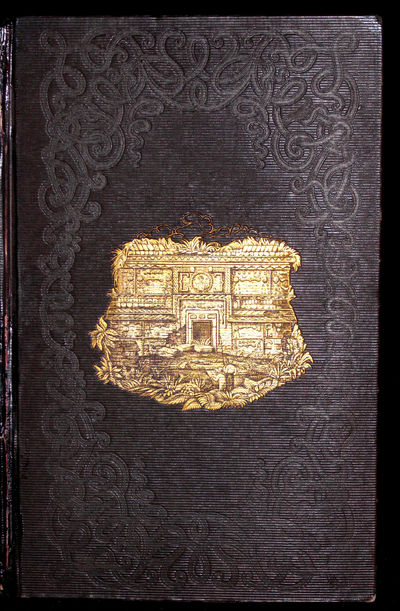
Rambles in Yucatan Including a Visit to the Remarkable Ruins of Chi-Chen, Kabah, Zayi, Uxmal and C
Norman, B. M New York., 1843. New York. J.& H.G. Lanangley 1843. Bound in original publisher's pictorial gilt decorated brown cloth. 8vo. 6"x9 The First Edition. Illustrated throughout by maps and full-page plates. Chipping to head piece. Well executed repairs to spine cloth at gutter. Pastedowns and endsheets somewhat soiled. previous owners ink signature and small label to front pastedown. Occasional mild sporadic foxing. A Very-Good crisp and bright copy. Carey & Hart #307.- $200
- $200
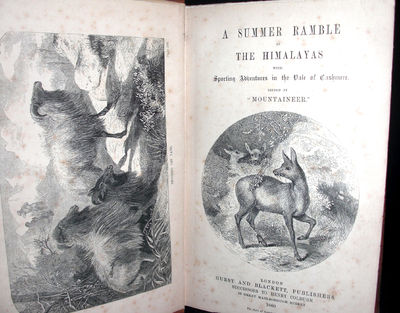
A Summer Ramble in the Himalayas, with, Sporting Adventures in the Vale of Cashmere
Wilson, William London., 1860. London. Hurst and Blackett. 1860. Bound in original publisher's pictorial gilt decorated brown cloth. 8vo. 6" x 9 The First Edition. Edited by "Mountaineer. Illustrated by an engraved Frontis and Title Page. Covers mildly soiled and rubbed. Corners a bit bumped. Sporadic foxing throughout. Spine unobtrusively cracked at Pg. 240. Repair to endsheet at rear gutter. A previous owners ink signatures to front paste down and front free endsheet. A Very-Good, crisp copy. Very rare in original cloth.- $425
- $425
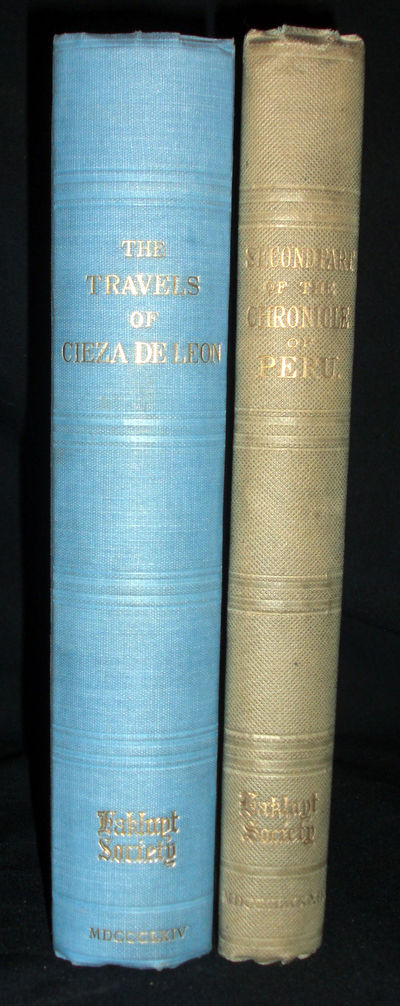
The Travels of Pedro De Cizea De Leon, A.D. 1532-50,- The Chronicle of Peru
De Leon, Pedro De Cieza London., 1864- 1883 London. Hakluyt Society. 1864- 1883 Bound in pictorial gilt titled and decorated blue cloth. Blind embossed decorations to front and rear covers. 8vo. 6" x9 The First Edition of the First Part (1864), the First Edition of the Second Part (1883). With 1864 Report of the Hakluyt Society bound-in to front of Vol. I. Illustrated by one linen-backed, hand-coloured folding map depicting Peru, Quito and new Granada Spine of Volume II sunned. Small previous owner's stamp to front-pastedowns. Sporadic mild foxing to map with offset to Title Page. A Very Good, crisp and bright copy of this extremely rare Issue.- $1,500
- $1,500

Pilot Training Manual for the P-38 Lightning
Washington D. C., 1944. Washington D. C. Headquarters-U.S. Army Air Forces. 1944. Punch and clipbound in stylized titled coloured pictorial wrappers. Thin 4to. Classified "Restricted" and marked as such on each page. The December 1944, Original "Brown Cover" issue. Profusely illustrated with photographs, drawings, maps, diagrams, charts, etc. During its time, the Lockheed P-38 Lightning was considered the most sophisticated aircraft Lockheed had ever built. In February 1937, the U.S. Army Air Corps released Specification X-608, a daunting requirement that called for speed, range, and climb capabilities impossible to achieve at that time with a single-engine aircraft. In Burbank, California, a Lockheed design team led by Hall Hibbard, and assisted by a young engineer named Clarence "Kelly" Johnson, immediately began a series of designs that would culminate in the contract-winning XP-38. Jim Gerschler became project engineer on the aircraft. The XP-38 (it was many months before it was called the Lightning) was of an extraordinarily advanced conception, an all-metal, midwing monoplane with twin Allison engines using General Electric turbo-superchargers, a central nacelle for the pilot and armament, contra-rotating propellers, twin-booms and rudders, and a tricycle landing gear. Nothing like it had ever been seen before, and it would be the only single-seat, twin-engine aircraft to reach mass production status during World War II. The distinctive sight and sound of the Lockheed P-38 Lightning would make it one of the best-known aircraft of the war. First flown on January 27, 1939, by one of its staunchest advocates, Air Corps 1st Lieutenant Ben Kelsey, the prototype XP-38 made national headlines when it crashed on a transcontinental record-setting attempt. Nevertheless, imminent war in Europe accentuated the need for the Lockheed P-38 Lightning, and production orders began to flow in. By war's end, a total of 10,037 P-38s had been built. As it was much more modern than the Curtiss P-40, there was a great demand in every theater of war for the twin-engine fighter. The big Lockheed P-38 Lightning had its greatest successes in the Pacific Theater, where the two leading aces, Majors Richard I. Bong and Thomas B. McGuire, scored 40 and 38 victories, respectively, using only the Lightning. The Lightning was also the only plane capable of carrying out the extraordinary 800-mile mission that climaxed with the shoot-down of the Mitsubishi "Betty" carrying Admiral Isoroku Yamamoto on April 18, 1943. Not as maneuverable as the Japanese fighters, the Lockheed P-38 Lightnings used dive and zoom tactics and their formidable center-line firepower of four .50-inch machine guns and a single 20-mm cannon to gain victories. It gave its pilots confidence on the daily long-distance flights over water, for if one engine was lost to combat or accident, the Lightning was able to limp home on the other. The Lockheed P-38 Lightning was less at home in Europe, where its large size made it less maneuverable than the German fighters it faced. Further, its Allison engines didn't operate as well at the high altitudes and cold temperatures of the European Theater. It became a workhorse nonetheless, doing duty in bomber escort, reconnaissance, and bombing, carrying as much as 4000 pounds of bombs in the latter role. One version of the P-38 was modified with a "droop-snoot" and carried a bombardier and either a Norden bombsight or a radar set. About 1,400 Lockheed P-38 Lightnings were completed as F-4 and F-5 reconnaissance planes, which were flown, unarmed and unafraid, deep within enemy territory. There were more Lightning reconnaissance planes than any other type in the USAAF. The Lockheed P-38 Lightning set many records. It was the only USAAF fighter to be in production prior to the start of the war and still in production on VJ-Day, August 15, 1945. It was the first fighter with sufficient range to make ferry flights across the Atlantic. It was also the first fighter for which compressibility problems were forecast, and among the first to experience compressibility. The P-38 was the first fighter to use power-boosted flight controls as well as the first to have a tricycle landing gear. Curiously, Lockheed did not have much luck in creating advanced versions of the Lightning. The more powerful XP-49 and XP-58 took too long to mature, and neither was successful. It really didn't matter, for the Lockheed P-38 Lightning was capable of doing all that was required of it. -The Editors of Publications International, Ltd. Several small splits to spine. Several tiny chips/creases to to fore-edge of front cover. Very mild Usual mild wear from metal binding pins to front and rear inside covers. A sensational, well preserved, clean copy.- $3,000
- $3,000
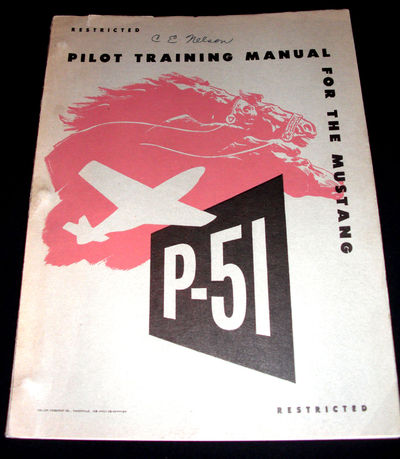
Pilot Training Manual for the P-51 Mustang
Washington D. C., 1944. Washington D. C. Headquarters-U.S. Army Air Forces. 1944. Punch and clipbound in stylized titled coloured pictorial wrappers. Thin 4to. Classified "Restricted" and marked as such on each page.This manual is for the P51-B and C, with several pages at end detailing the "Teardrop" D type - which was still in production at the time this manual was produced. Profusely illustrated with photographs, drawings, maps, diagrams, charts, etc. The P-51 Mustang was,with little argument, the single greatest American Fighter Aircraft of World War 2. The sleek, low winged Mustang was among the very first to use a laminar-flow wing, which resulted in far less drag. Also, the P-51 had its wingtips, rudder, and elevators with square-cut ends, unlike almost every other aircraft at the time. It paid off, as the P-51 could reach 380mph while the lighter Spitfire, with half as much fuel weight, could not get within 15mph of that figure. The P-51 Mustang, designed in 1940 after Great Britain requested that North American build P-40 Warhawks for the Royal Air Force, was at first ignored by U. S. officials. However, the design showed such promise that in 1941 the Army Air Forces took delivery of P-51A's powered by the Allison V-1710 engine. These early Mustangs were restricted to reconnaissance and ground attack due to the limited performance of the Allison engines. Tests in 1942 with the Roll-Royce "Merlin" engine showed a marked increase in performance. By the end of 1943, Merlin powered P-51Bs entered combat with the 354th Fighter Group in England. Eighth Air Force Mustangs provided long range escort to B-17s and B-24s and scored heavily over German interceptors. By the war's end, P-51s had destroyed 4,950 enemy aircraft in the air, more than any other U. S. fighter in Europe. Mustangs served in nearly every active combat zone, including the Pacific where they escorted B-29s from Iwo Jima to Japan. Between 1941 and 1945, the Army Air Force ordered 14,855 Mustangs. During the Korean Conflict, P-51's were used primarily for close support of ground forces until withdrawn from combat in 1953. P-51s served with Reserve and National Guard units until 1957. Ink stamp of Salem Army Airdrome HQ dated 1945 to title Page and inside rear cover. Tiny tear to top edge of cover. Owners name in ink to front cover.Small chip to top of spine.Various small stains at spine on rear cover. Usual rust offset from metal binding pins to front and rear inside covers. to front and rear inside covers. A remarkably preserved, clean and crisp copy of this most rare and desirable relic.- $2,500
- $2,500
The Peruvians at Home: https://rarebookinsider.com/rare-books/the-peruvians-at-home/